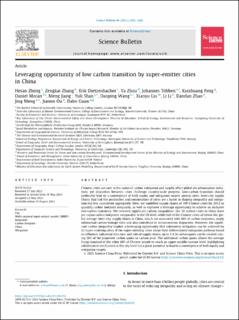| dc.contributor.author | Zheng, Heran | |
| dc.contributor.author | Zhang, Zengkai | |
| dc.contributor.author | Dietzenbacher, Erik | |
| dc.contributor.author | Zhou, Ya | |
| dc.contributor.author | Többen, Johannes Reinhard | |
| dc.contributor.author | Feng, Kuishuang | |
| dc.contributor.author | Moran, Daniel | |
| dc.contributor.author | Jiang, Meng | |
| dc.contributor.author | Shan, Yuli | |
| dc.contributor.author | Wang, Daoping | |
| dc.contributor.author | Liu, Xiaoyu | |
| dc.contributor.author | Li, Li | |
| dc.contributor.author | Zhao, Dandan | |
| dc.contributor.author | Meng, Jing | |
| dc.contributor.author | Ou, Jiamin | |
| dc.contributor.author | Guan, Dabo | |
| dc.date.accessioned | 2023-12-04T07:52:02Z | |
| dc.date.available | 2023-12-04T07:52:02Z | |
| dc.date.created | 2023-09-08T13:17:17Z | |
| dc.date.issued | 2023 | |
| dc.identifier.citation | Science Bulletin. 2023, 68, 2456-2466. | en_US |
| dc.identifier.issn | 2095-9273 | |
| dc.identifier.uri | https://hdl.handle.net/11250/3105692 | |
| dc.description.abstract | Chinese cities are core in the national carbon mitigation and largely affect global decarbonisation initiatives, yet disparities between cities challenge country-wide progress. Low-carbon transition should preferably lead to a convergence of both equity and mitigation targets among cities. Inter-city supply chains that link the production and consumption of cities are a factor in shaping inequality and mitigation but less considered aggregately. Here, we modelled supply chains of 309 Chinese cities for 2012 to quantify carbon footprint inequality, as well as explored a leverage opportunity to achieve an inclusive low-carbon transition. We revealed significant carbon inequalities: the 10 richest cities in China have per capita carbon footprints comparable to the US level, while half of the Chinese cities sit below the global average. Inter-city supply chains in China, which are associated with 80% of carbon emissions, imply substantial carbon leakage risks and also contribute to socioeconomic disparities. However, the significant carbon inequality implies a leveraging opportunity that substantial mitigation can be achieved by 32 super-emitting cities. If the super-emitting cities adopt their differentiated mitigation pathway based on affluence, industrial structure, and role of supply chains, up to 1.4 Gt carbon quota can be created, raising 30% of the projected carbon quota to carbon peak. The additional carbon quota allows the average living standard of the other 60% of Chinese people to reach an upper-middle-income level, highlighting collaborative mechanism at the city level has a great potential to lead to a convergence of both equity and mitigation targets. | en_US |
| dc.language.iso | eng | en_US |
| dc.rights | Navngivelse 4.0 Internasjonal | * |
| dc.rights.uri | http://creativecommons.org/licenses/by/4.0/deed.no | * |
| dc.title | Leveraging opportunity of low carbon transition by super-emitter cities in China | en_US |
| dc.title.alternative | Leveraging opportunity of low carbon transition by super-emitter cities in China | en_US |
| dc.type | Peer reviewed | en_US |
| dc.type | Journal article | en_US |
| dc.description.version | publishedVersion | en_US |
| dc.rights.holder | © 2023 Science China Press. Published by Elsevier B.V. and Science China Press. | en_US |
| dc.source.pagenumber | 2456-2466 | en_US |
| dc.source.volume | 68 | en_US |
| dc.source.journal | Science Bulletin | en_US |
| dc.identifier.doi | 10.1016/j.scib.2023.08.016 | |
| dc.identifier.cristin | 2173520 | |
| dc.relation.project | Norges forskningsråd: 287690 | en_US |
| cristin.ispublished | true | |
| cristin.fulltext | original | |
| cristin.qualitycode | 1 | |

